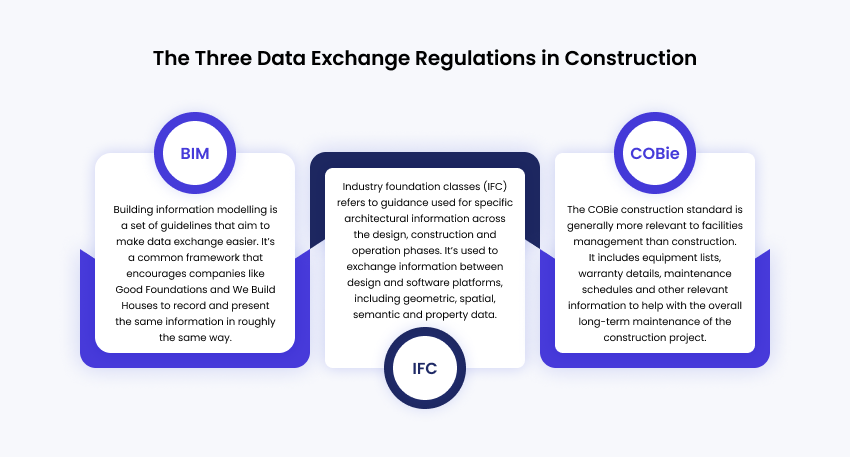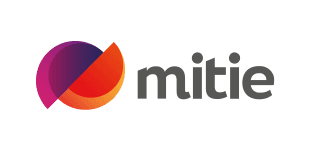If there’s a term that gets the blood racing less than ‘data exchange’, I’d challenge you to find it.
Nonetheless, it’s a pretty important way to make sure your projects stay on track and within budget, while keeping your profit margins intact. So, let’s dive in.
What is data exchange in construction?
Data exchange in construction refers to the process of sharing information among relevant stakeholders in the project.
This could include:
- Materials and quantities
- Ongoing project costs
- Project specifications
- Design briefs
- Technical designs
- Product information
These are just a few examples, but really it could involve anything.
Construction projects are infamously complex, with many moving parts and, crucially, many stakeholders.
Whether it’s architects, clients, engineers, contractors or quantity surveyors – projects rely on smooth communication between everybody.
But here’s the issue: The chances of all these stakeholders working for the same company are practically nil
And each organisation will have their own software, templates and infuriatingly unique ways of recording and presenting information.
So how do you get everybody on the same page?
That, at its crux, is the challenge of data exchange – and why it’s so important to get it right.
The issue with bad data exchange
To manage the challenge of data exchange in construction, companies generally follow a series of industry-recognised compliance standards (more on these below).
In short, these ensure that the way they record and present information is consistent from stakeholder to stakeholder and company to company.
The idea is, if everybody records roughly the same information in roughly the same way, it’s going to make everybody’s lives a lot easier.
Let’s look at an example to understand this in more detail: A fictional construction company called Good Foundations.
They’ve been contracted to build a house on behalf of a Real Estate Developer called We Build Houses.
Halfway through the project, it’s time to check in and go over the finances to see if the project is on track and within budget.
But here’s the issue: We Build Houses uses a market-leading construction accounting tool (almost certainly Archdesk) which ensures they’re compliant and record all the information they need to keep track of their finances.
It really does make their lives a breeze.
Good Foundations aren’t as scrupulous – they keep everything in Excel sheets and aren’t always consistent about what they track or how they do it.
For We Build Houses, this is a nightmare.
They spend hours scouring through these impenetrable Excel labyrinths just to work out what’s what. And then, they have to manually add that information into Archdesk.
It takes ages and if they get it wrong, they might not spot when errors occur or projects run over.
Ultimately, it wastes time and risks the stability of projects. All this means Good Foundation’s chances of winning another contract are pretty slim.
Done right, however, good data exchange can mean:
- Improved accuracy
- Fewer tiring admin tasks
- Improved knowledge transfer between stakeholders
- Reduced change orders
So how do you get it right?
BIM construction: How to get data exchange right
Building information modelling, or BIM, is a set of guidelines that aim to make data exchange easier.
It was developed in the UK and is now considered the gold standard across the global construction industry.
In short, it’s a common framework that encourages companies like Good Foundations and We Build Houses to record and present the same information in roughly the same way.
The most up-to-date version is BIM Level 2.
BIM isn’t specific to a particular software or platform – different companies don’t need to use the same technology to be BIM-compliant.
But if different software platforms and companies essentially speak the same language – it makes data exchange much, much easier.
Here are some of the principles the BIM discusses:
- Information requirements: Emphasising the need for clear information for each project stage, including an agreed level of detail and level of information to be shared.
- Common data environment: Promoting the use of a common framework for measuring and presenting data between different software platforms.
- Interoperability: Encouraging software tools to easily integrate and transfer information between each other.
- Project standards: Establishing the need for consistent protocols across the project, including file naming conventions and data exchange formats.
- Collaboration and communication: Creating clear roles and responsibilities between stakeholders for effective communication.
- Classification systems: Promoting the use of standard classification systems for organising project information. This includes systems such as COBie, discussed in further detail below.
Though not legally binding, building information modelling is now considered pretty standard across the industry. Check out the website to find out more about the BIM standards.

Regulations upon regulations
It would be nice if there was just one set of regulations to follow, wouldn’t it? Just once?
No sadly, not, because there are two other data exchange in construction standards. It's also useful to get your head around: COBie and IFC.
Luckily, you don’t have to choose between using BIM or either of these, since both are used for more specific tasks within the wider BIM framework:
IFC construction standard
Industry foundation classes (IFC) refers to guidance that’s used for specific architectural information across the design, construction and operation phases.
It’s often used to exchange information between different design and software platforms, including geometric, spatial, semantic and property data.
COBie
The COBie construction standard (Construction Operations Building Information Exchange.
Catchy, right?) is generally more relevant to facilities management than construction, so you might not need to worry about this unless you’re involved in project handover or creating documentation.
It generally includes equipment lists, warranty details, maintenance schedules and other relevant information to help with the overall long-term maintenance of the construction project.

It’s difficult to give you a one-size-fits-all framework that’ll solve all your data exchange issues.
Construction projects are far too complex for that – and you’ll find yourself needing to use different standards on different projects.
But if in doubt, stick to BIM Level 2 and you’ll have most of your boxes ticked.
Data drop in construction
The whole point of the BIM framework is to ensure that important information is transferred between key stakeholders at regular intervals during the project.
Such opportunities for data exchange are referred to as ‘data drops’. Every project you work on should do this frequently – whether that’s simply monthly or at key points during the project.
There is no compulsory schedule for data drops with BIM, but the framework proposes that they should ideally happen after each of the relevant project stages:
- Strategy
- Brief
- Concept
- Definition
- Design
- Build and commission
- Handover and closeout
- Operation and end of life
Not all these will be relevant to every project, so definitely take this with a pinch of salt.
But if you’re trying to work out when you should be sharing information with relevant stakeholders, this is definitely a good place to start.
Making BIM a breeze
Data exchange in construction certainly isn’t simple or straightforward – but it’s a big part of making sure that construction projects run smoothly. So where do you start?
If you’re relying on Excel documents or paper processes to record your information, data exchange is going to be a real challenge.
It is possible to be compliant with these processes – but it’s certainly not easy. However, there is another way.
For many organisations, the best solution is to use a specialist construction software platform – like Archdesk.
These are designed around frameworks like BIM, ensuring you’re always recording the right information.
That way, you just need to worry about sending the information to your stakeholders at the right time.
Sounds good right? Give it a go today.
Frequently Asked Questions (FAQs)
What is the purpose of data exchange in construction?
Data exchange in construction describes how companies record and share information at different stages of the construction project, to improve collaboration, transparency and efficiency.
What is open data exchange in BIM?
Building information modelling, or BIM, is the internationally recognised framework that construction companies use to simplify the sharing of relevant project information.
What is an example of a data exchange?
A data exchange example could be sharing information on ongoing project costs and timelines, so all parties can clearly see whether the project is on schedule and can make informed decisions about how to proceed.
How is data used in the construction industry?
Data is used to share important information about ongoing projects, budgets, schematic plans and other vital documents. Organisations use BIM, COBie, IFC or some combination of all three to simplify and expedite their data exchanges at all stages of the project.















